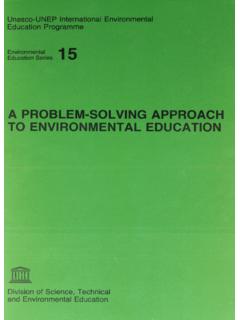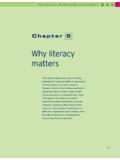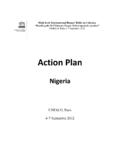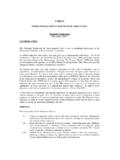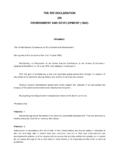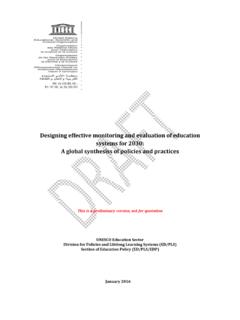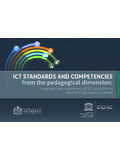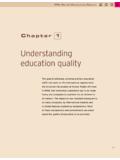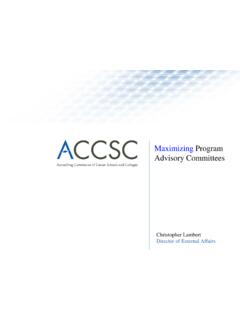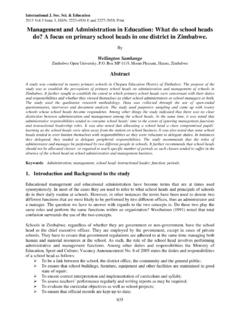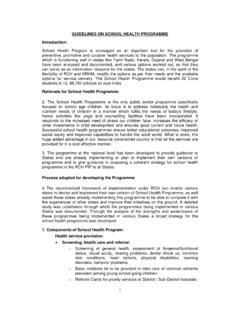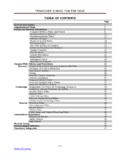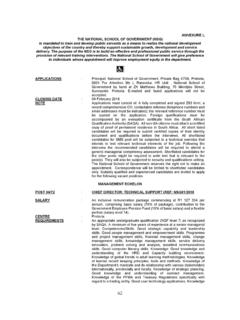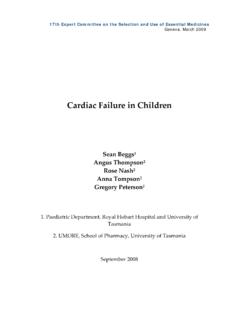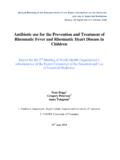Transcription of Comprehensive School Safety - UNESCO
1 Working towards a global framework for climate-smart disaster risk reduction, bridging development and humanitarian action in the education sector. March 2013 Comprehensive School SafetyThe Three Pillars of Comprehensive School SafetyComprehensive School Safety is addressed by education policy and practices aligned with disaster management at national, regional, district and local School site levels. It rests on three pillars:1. Safe Learning Facilities2. School Disaster Management3. Risk Reduction and Resilience EducationMulti-hazard risk assessment is the foundation for planning for Comprehensive School Safety . Ideally, this should be part of Educational management Information Systems at national, subnational and local levels.
2 It is part of a broader analysis of education sector policy and management in order to provide the evidence base for planning and past decade has brought children s advocates together: To promote disaster risk reduction (Hyogo Framework for Action 2005-2015) throughout the education sector along with education for sustainable development (International Decade for Education for Sustainable Development) To assure universal access to quality basic education (Millenium Development Goals, Education for All, Global Partnership for Education, Education First). To incorporate risk reduction into Millenium Development Goals for the core of these child-centered, child-participatory, and evidence-based efforts are the recognition of children s rights to survival and protection as well as to education and purpose of this framework for Comprehensive School Safety is to bring these efforts into a clear and unified focus in order for education sector partners to work more effectively, as well as to link with similar efforts in all other Goals of Comprehensive School SafetyThe goals of Comprehensive School Safety are.
3 To protect learners and education workers from death, injury, and harm in schools To plan for educational continuity in the face of expected hazards To safeguard education sector investments To strengthen climate-smart disaster resilience through educationPhotos: Save the Children, Conor Ashleigh/Save the Children, and Plan InternationalPillar 1. Safe Learning FacilitiesPillar 2. School Disaster ManagementPillar 3. Risk Reduction and Resilience Education Safe site selection Building codes Performance standards Disaster resilient design Assessment & Planning Physical & Environmental Protection Response Skills & Provisions Building maintenance Non-structural mitigation Fire Safety Household disaster plan Family reuni cation plan School drills Structural Safety education Construction as educational opportunity Formal curriculum integrations & infusion Teacher training & sta development Representative/participatory SDM committee Educational continuity plan Standard operating
4 Procedures Contingency planning Extracurricular & community-based informal education Builder training Construction supervision Quality control Remodelling Retro tEducation Sector Policies and PlansAligned to national, subnational and local disaster management plans multi-hazard risk assessment education sector analysis child-centred assessment & planningThree Pillars of Comprehensive School Safety1. Safe Learning Facilities involves education authorities, architects, engineers, builders and School community members in safe site selection, design, construction and maintenance (including safe and continuous access to the facility).
5 The key responsibilities for both public and private schools are to: Select safe School sites and implement disaster-resilient design and construction to make every new School a safe School . Implement prioritization schema for retrofit and replacement (including relocation) of unsafe schools. Minimize building and facilities non-structural and infrastructural risks from all sources, including design as well as interior layout and furnishings safe for survival and evacuation. Incorporate access and Safety for people with disabilities in design and construction of School facilities. If schools are planned as temporary community shelters, design them to meet these needs.
6 And be sure to plan for suitable alternate facilities for educational continuity. Ensure that children s access to schools is free from physical risks (pedestrian paths, road and river crossings) Water and sanitation facilities adapted to potential risks (rain-fed and lined latrines) Implement climate-smart interventions such as rainwater harvesting, solar panels, renewable energy, School gardens Plan for continuous monitoring, financing and oversight for ongoing facilities maintenance and School Disaster management is established via national and sub-national education authorities and local School communities (including children and parents)
7 , working in collaboration with their disaster management counterparts at each jurisdiction, in order to maintain safe learning environments and plan for educational continuity, conforming to international standards. The key responsibilities are to: Provide policies, guidance at sub-national and School -site levels for ongoing site-based assessment and planning, risk reduction, and response preparedness as part of normal School management and improvement. Develop, train, institutionalize, monitor and evaluate School -site committees. These should be empowered to lead identification and mapping of hazards inside and outside School and community and action-planning for ongoing disaster risk reduction and preparedness activities.
8 Encourage participation of staff, students, parents and community stakeholders in this work. Adapt standard operating procedures as needed, for hazards with and without warnings, including: drop cover and hold, building evacuation, evacuation to safe haven, shelter-in-place and lockdown, and safe family reunification. Engage schools in making early warning and early action systems meaningful and effective. Establish national and sub-national contingency plans, based on Interagency Network for Education in Emergencies (INEE) Minimum Standards (2010), to support educational continuity, including plans and criteria to limit the use of schools as temporary shelters.
9 Identify alternate locations for temporary schools and alternate modes of instruction Incorporate the needs of pre- School and out-of- School children, children with disabilities, and both girls and boys. Link education sector and disaster management sector policies and plans at each level of social organization (national, sub-national levels, and local and School -site level) and establish communication and coordination linkages across sectors. Practice, critically evaluate, and improve on response preparedness, with regular School -wide and community-linked simulation drills. Adapt standard operating procedures to specific context of each Risk Reduction and Resilience Education should be designed to develop a culture of Safety and resilient communities.
10 Key responsibilities are to: Develop consensus-based key messages for reducing household and community vulnerabilities, and for preparing for and responding to hazard impacts as a foundation for formal and non-formal education. Engage students in real-life School and community disaster management activities, including School drills for fire (and other hazards, where applicable). Develop scope and sequence for teaching about critical thinking for expected and unexpected, man-made and natural hazards, climate change impacts, conflict-prevention and problem-solving for risk reduction. Develop quality teaching and learning materials for students and teachers.

